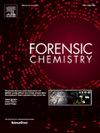Analysis of automotive lubricating grease residue: A forensic investigation using ATR-FTIR spectroscopic and chemometric interpretation
IF 2.6
3区 医学
Q2 CHEMISTRY, ANALYTICAL
引用次数: 0
Abstract
Automotive lubricating greases are widely utilized in automobiles, making them frequently encountered trace evidence in incidents involving a vehicle's collision with another vehicle, person, animal, or stationary object. Due to their high transferability, lubricating grease can act as valuable corroborative evidence during crime scene investigations. They can assist in establishing a link between the vehicle and the individual (victim or accused) to the crime scene, while also confirming contact between the vehicle and the victim. In this study, 21 brands of automotive lubricating grease samples were analyzed for their identification and differentiation, employing a rapid and non-destructive ATR-FTIR spectroscopic technique combined with chemometrics. ATR-FTIR spectra of all samples were visually examined and categorized into six groups based on their similarities and differences. After visual examination, the training dataset was subjected to chemometric analysis using PCA and SVM tools. PCA was employed to explore trends within the dataset, while SVM classified samples, achieving 97.62 % training accuracy and 88.09 % external validation accuracy. To ensure an unbiased validation of the SVM model, the training and validation datasets were comprised of a distinct set of spectra. A blind test validated the SVM model, resulting in 100 % prediction accuracy. Additionally, a study was performed to evaluate how substrate type, storage conditions, and storage duration could affect the linking of the substrate grease samples to their source. The findings revealed that the above-mentioned factors, particularly sunlight exposure and the washing of the substrate grease samples, significantly influence the SVM prediction accuracy.
汽车润滑油脂残留物的分析:ATR-FTIR光谱和化学计量学解释的法医调查
汽车润滑脂在汽车上的应用非常广泛,在车辆与其他车辆、人、动物或静止物体的碰撞事故中,润滑脂经常成为痕迹证据。润滑脂具有很高的可转移性,在犯罪现场调查中可以作为有价值的确证。它们可以帮助建立车辆与犯罪现场的个人(受害者或被告)之间的联系,同时也确认车辆与受害者之间的联系。本研究采用快速、无损的ATR-FTIR光谱技术结合化学计量学,对21个品牌的汽车润滑脂样品进行了鉴定和区分。对所有样品的ATR-FTIR光谱进行目测,并根据相似性和差异性将其分为6组。目视检查后,使用主成分分析和支持向量机工具对训练数据进行化学计量分析。采用PCA对数据集中的趋势进行挖掘,SVM对样本进行分类,训练准确率达到97.62%,外部验证准确率达到88.09%。为了确保支持向量机模型的无偏验证,训练和验证数据集由一组不同的光谱组成。盲测试验证了SVM模型,预测准确率达到100%。此外,还进行了一项研究,以评估基材类型、储存条件和储存时间如何影响基材油脂样品与其来源的连接。结果表明,上述因素,特别是阳光照射和衬底油脂样品的洗涤,显著影响SVM的预测精度。
本文章由计算机程序翻译,如有差异,请以英文原文为准。
求助全文
约1分钟内获得全文
求助全文
来源期刊

Forensic Chemistry
CHEMISTRY, ANALYTICAL-
CiteScore
5.70
自引率
14.80%
发文量
65
审稿时长
46 days
期刊介绍:
Forensic Chemistry publishes high quality manuscripts focusing on the theory, research and application of any chemical science to forensic analysis. The scope of the journal includes fundamental advancements that result in a better understanding of the evidentiary significance derived from the physical and chemical analysis of materials. The scope of Forensic Chemistry will also include the application and or development of any molecular and atomic spectrochemical technique, electrochemical techniques, sensors, surface characterization techniques, mass spectrometry, nuclear magnetic resonance, chemometrics and statistics, and separation sciences (e.g. chromatography) that provide insight into the forensic analysis of materials. Evidential topics of interest to the journal include, but are not limited to, fingerprint analysis, drug analysis, ignitable liquid residue analysis, explosives detection and analysis, the characterization and comparison of trace evidence (glass, fibers, paints and polymers, tapes, soils and other materials), ink and paper analysis, gunshot residue analysis, synthetic pathways for drugs, toxicology and the analysis and chemistry associated with the components of fingermarks. The journal is particularly interested in receiving manuscripts that report advances in the forensic interpretation of chemical evidence. Technology Readiness Level: When submitting an article to Forensic Chemistry, all authors will be asked to self-assign a Technology Readiness Level (TRL) to their article. The purpose of the TRL system is to help readers understand the level of maturity of an idea or method, to help track the evolution of readiness of a given technique or method, and to help filter published articles by the expected ease of implementation in an operation setting within a crime lab.
 求助内容:
求助内容: 应助结果提醒方式:
应助结果提醒方式:


